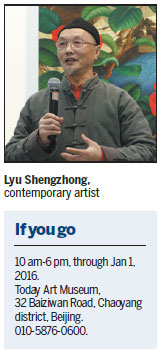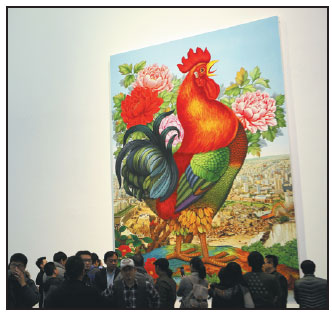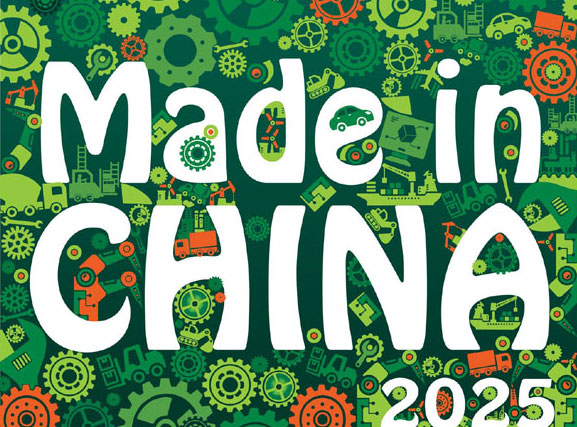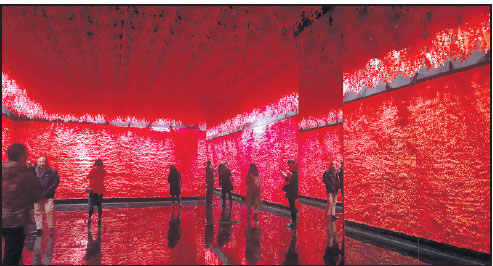Tweaking traditional art
Updated: 2015-12-08 08:02
By Lin Qi(China Daily)
|
|||||||||||
Contemporary artist Lyu Shengzhong shows how an ancient Chinese craft can be reinterpreted in modern times. Lin Qi reports.
The last time contemporary artist Lyu Shengzhong, 63, held a solo exhibition was five years ago in New York. Titled A Decade, the show at Chambers Fine Art marked the 10th anniversary of the introduction of his avantgarde reinterpretation of Chinese paper-cuts to an American audience.
In his current solo exhibition, titled Last Century, at Beijing's Today Art Museum, Lyu expresses his nostalgia for the time before 2000.
"There weren't so many art galleries and museums. Artists did not have spacious and well-equipped studios. The market was not exuberant and art brokers didn't get a chance to push up prices," he says.
Last Century displays dozens of Lyu's paintings and installations in which he digs further into the motifs recurring in his art - folk culture, modern transformation and life.
Lyu views the last two decades of the 20th century as the start of his artistic journey.
He reflects on the cultural and social landscapes of China back then, through which he hopes to find solutions to problems of today.
He especially ponders on how traditions are inherited and merged into people's value systems.
Lyu rose to prominence in the late 1980s.
At a solo exhibition at the National Art Museum of China in 1988, he stunned people with paper-cuts in which he translated the folk art form into a vanguard style.
He drew much attention for repeating in his works the image of "little red man", a common subject in papercuts in northwestern China, which he says symbolize the roots of a civilization.
Born in rural Shandong province, Lyu took an interest in paper-cuts from childhood by watching families and local people in his East China village scissoring beautiful patterns out of paper.
In college, he traveled to northern Shaanxi province where he was influenced by rich folk art. There he learned about shaping human figures from an elderly woman. And in those vivid little paper men he sensed an infinite power that is "universal to early civilizations".
Lyu continuously explores themes using the "little red man" and other folk patterns in his works.
His current exhibition features different forms being transformed into two-and three-dimensional creations.
Wall of Men, a work at the Beijing show, occupies the wall and the ceiling of the exhibition hall with more than 600,000 paper-cuts of the "little red man".
The early success of the "little red man" won Lyu many invitations to exhibit abroad but also led to in-depth thoughts about his culture.
"For several years after 1992, I traveled by plane five to six times a year, feeling weary of the busy exhibition schedule," he recalls.

"Often I was asked to create works that would meet Westerners' preconceptions of Chinese art and artists. I felt like a side dish at a feast of Western culture. But looking back home, I saw a barren scene of home-grown culture. I felt we artists had no interaction with society."
He also wondered if his works had any value in China. As an artist he won applause in the West but saw little appreciation back home.
Lyu slowed down his pace of exhibiting in 2004. That year he became a founding professor of the experimental art department at Beijing's Central Academy of Fine Arts. He saw his new role as a chance to cultivate artists who can think and create more independently.
He plunges into teaching in the daytime. But for hours at night he assumes the role of an artist.
Lyu's ongoing exhibition has several experimental creations.
In the installation, Study of Mountain and Water, he re-creates a schoolroom reminiscent of the literary and philosophical pursuits of China's ancient scholars.
Lyu says the work met his need to express an artist's independent personality when preparing for an exhibition.
"Chinese contemporary art in its infancy was often portrayed as anti-tradition and anti-academic."
It then toned down its anti-tradition gist, but as it has matured in technique, it has become weaker in ideas, he says.
"I hope that we no longer look to the West for critiques," he says. "What we need to do is draw on our own experiences and listen to the voices deep in our hearts."
Gao Peng, director of the Today Art Museum and curator of Lyu's exhibition, says the exhibition is a culmination of the artist's 30-year commitment to art but is also a beginning.
"Many artists who were once Lyu's students have surpassed him in fame. But he is still a contemporary artist of great significance and will remain so in the future."
Contact the writer at linqi@chinadaily.com.cn
|
Above:Wall of Men, by Lyu Shengzhong, features more than 600,000 papercuts of 'little red men'. Below: Visitors in front of Lyu's oil work, A Big Rooster, which is inspired by Chinese New Year paintings. Photos Provided To China Daily |

(China Daily 12/08/2015 page18)
Today's Top News
Beijing issues first red alert for heavy air pollution
Obama vows to defeat terrorist threat
Man charged over 'terrorist incident' at London metro
10 major programs to boost China-Africa co-op
Putin sees positive trends in Russia's economy
Russian and Turkish finance ministers hold talks
Xi in South Africa to boost China-Africa cooperation
SOEs face headwinds as 21% witness profits decline
Hot Topics
Lunar probe , China growth forecasts, Emission rules get tougher, China seen through 'colored lens', International board,
Editor's Picks

|

|

|

|

|

|







